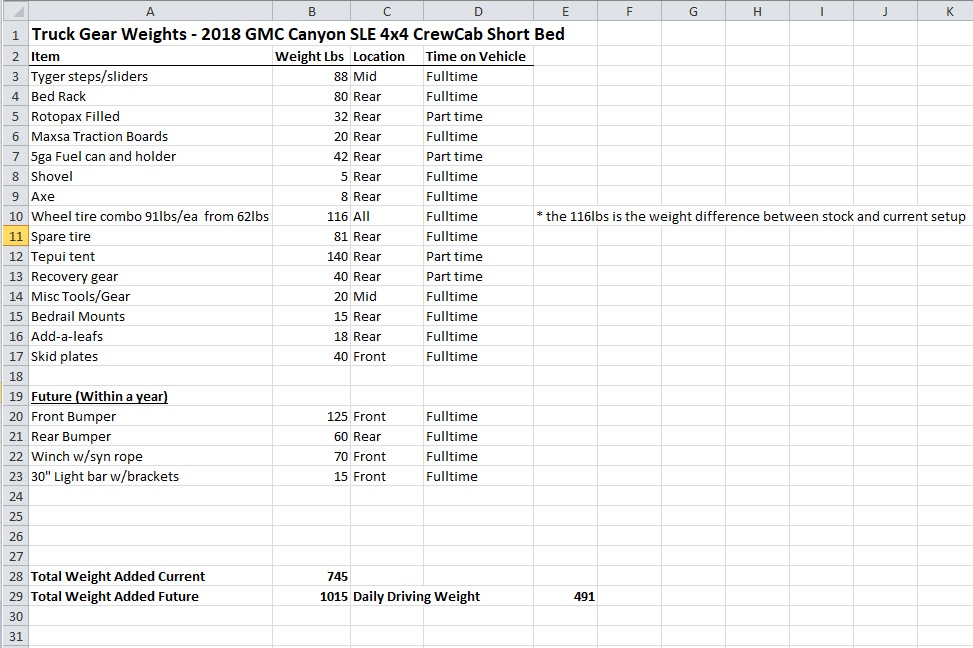We are evangelical about GVWR. It's absolutely critical if you want to travel internationally. For the occasional trip on private property like ranching, as another poster mentioned, it's not as critical, but for any kind of vehicle-based travel I think it is really important. And I'd wager that a lot of rigs that are set up to be "Expo Cool" are probably over the GVWR, especially if they are really built up smaller SUVs, like Jeeps.
Our previous overlanding rig was a Jeep JK Rubicon -- what many argue is the best Overlanding platform available in North America.
Only, it isn't.
I'll explain why for anyone who doesn't know this and stumbles on this thread:
There are 3 important numbers to pay attention to with rigs. The first is the Curb Weight. This is how much an empty, bone-stock vehicle weighs with full fluids parked at the curb, just like the name implies.
The second is GVWR (Gross Vehicle Weight Rating). This is the maximum allowable weight of the vehicle. There may also be a number associated which is the Combined GVWR -- it's a number that the rig and trailer cannot exceed. Since there is another thread on trailers I won't go into that here. The GVWR is the maximum weight the vehicle was designed to be, and there is some limiting factor -- tires, bearings, axles, transmission, engine, suspension, etc. -- that means the engineers have said "This, and no more".
The third and final number -- which is, I'd argue, the most important -- is Payload. GVWR minus Curb Weight = Payload. Payload is how much stuff you can bring, and is meant to include the weight of the driver, passengers, family dog, luggage, etc. What people forget is that it also includes all those snazzy aftermarket bits and pieces, and those add up fast. 150 lbs for a steel bumper. 100 lbs for a winch. 150 lbs for a RTT, etc.
So why do I think the JK Rubicon, or even the JL Rubicon, is not the best platform? Because the Payload is only 750-800 lbs. Just me, my wife, and our dog take up over half that payload in a stock jeep. By the time you add even basic camping gear and luggage for a week away, we are easily over the payload capacity. I'm not saying you cannot use the jeep for overlanding -- you absolutely can, and thousands do -- we did for years! But, you have to take a backpacker mentality to it. Small, light, compact is the only way to live long-term out of a JK on a multi-month expedition and respect it's GVWR. If you have your heart set on a fridge, an RTT, bull bar, winch, and expo-cool rear tire carrier with 3 jerry cans off the side, you will find that the Jeep is not suitable. The same is true for a lot of smaller SUVs.
"But ChasingOurTrunks, you said that GVWR is limited by components, so I can increase that number by upgrading suspension and such, can't I?!", Yes, I did say that and functionally, replacing components would increase capacity so that's true!
Only, it isn't.
The GVWR is a number that manufacturers set, and it cannot be changed legally. The numbers printed on the door jam are the numbers associated with the VIN of your vehicle. It doesn't matter if you upgrade every single component in the rig, it will still have the same GVWR according to one, very important stakeholder: The Insurance Company.
You can get away with overloading a rig in some jurisdictions, but in others you may find that being overweight voids your insurance coverage, and can expose you to extreme liability in an accident. You may also find that some countries will deny you entry (or deny you insurance which denies you entry in effect). And even though I've been disagreed with on other forums, an overloaded rig will have a higher rate of component failure than one that is kept within the weight limits it was designed for.
We went through every piece of gear we had and weighed it down to the gram, and ultimately this exercise is why we replaced our Jeep with a mid-size truck with 1500lbs payload capacity. For the kind of travel we do, we needed the extra weight capacity.
What I suggest folks do is they pick a rainy Saturday when they aren't out adventuring, and take ALL of the gear they typically bring on a trip and the bathroom scale. Weigh every piece of it and record it in a spreadsheet; every time you add or subtract gear, toss it on the scale and update the spreadsheet. Toss the weights of people in there too -- if you lose 50 lbs, update it. The goal is to create a database of your "Payload" -- you'll know, down to the pound, how much weight your are bringing on a trip.
Then, find out how much your existing accessories weigh. If a lot of stuff is bolted on or is difficult to find the weights of online, just go to the nearest trucker scale -- there are plenty all over the US and Canada, always near major roads (interstates, Trans Canada, etc.) and find out how much your new "Curb Weight" is with all your accessories bolted on. You may find your payload is lacking -- if that's the case, you only have three options:
1) Bring less stuff
2) Buy lighter accessories.
3) Take your chances with an overloaded rig.









